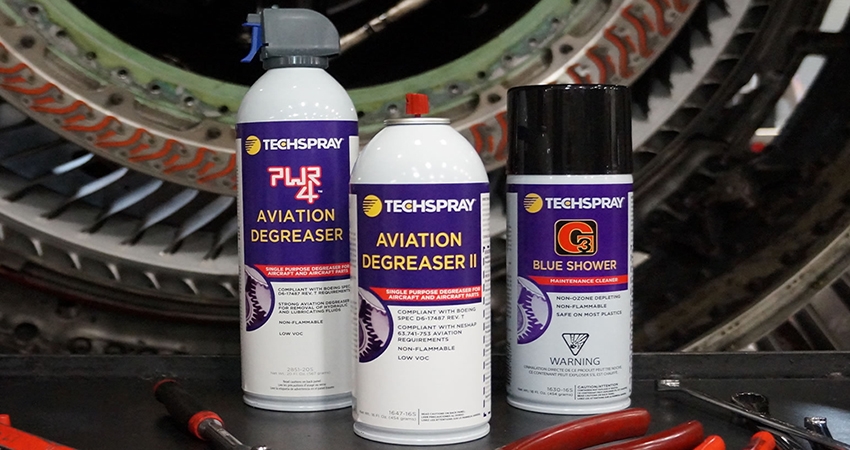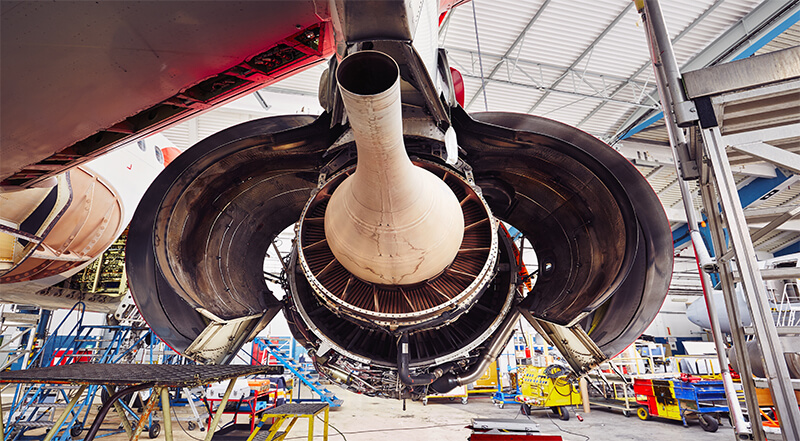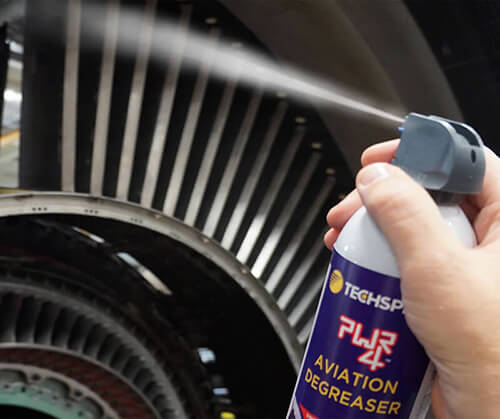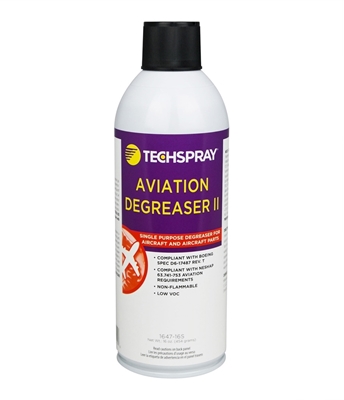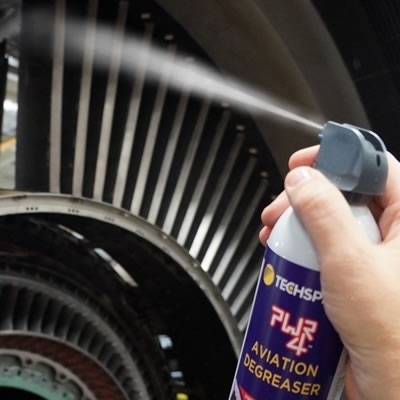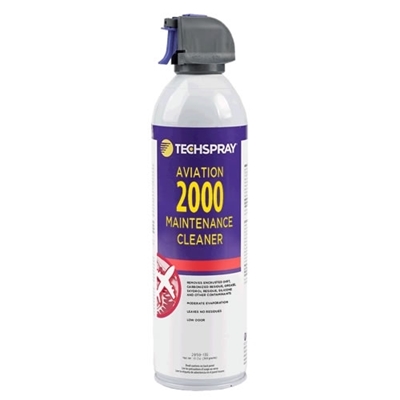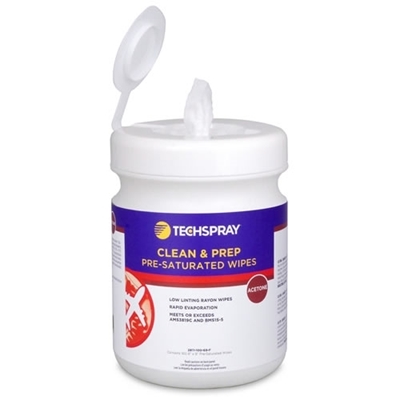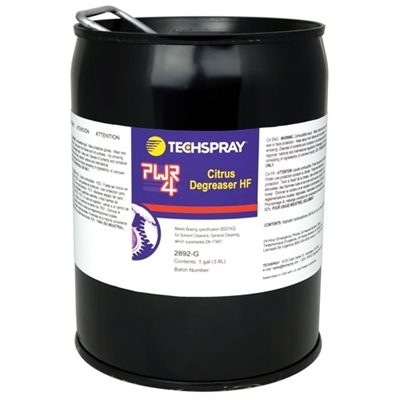By Ed Vickless, Director Aerospace Business Development, Techspray
A major freight company with a large fleet of aircraft was looking for a new solvent cleaner for their maintenance operation. Their health and safety engineers flagged the current aerosol cleaner as a health risk. Therefore, the purchasing department was instructed to locate a suitable replacement.
Their current maintenance cleaner contained n-Propyl Bromide (nPB), a chemical that poses a number of health risks and requires layers of personal protective equipment to be used safely. That level of safety is manageable during parts of the operation, such as engine tear down, because vapor degreasers and more automated methods of cleaning may be utilized. On the other hand, during letter checks on the line or hangar maintenance situations, it's difficult to promote the proper use of PPE.
n-Propyl Bromide Health Hazards
N-Propyl Bromide is a toxic chemical commonly used during aviation MRO. The chemical is used in a variety of industrial cleaners and degreasers such as aerosol cleaners, vapor degreasers, ultrasonic cleaning equipment, and immersion cleaning. NPB is commonly used as an industrial cleaner because it is nonflammable, has high solvency, and meets many aerospace manufacturers standards. Ironically, it has been billed as a “safer” alternative to legacy solvent cleaners like Trichloroethylene (TCE) and Perchloroethylene (Perc) but has since been shown to have safety issues of its own.
There are cited examples where workers suffered major health effects when exposed to high levels of nPB. Workers reported headaches, dizziness, and even loss of full body control. Further studies have shown a possible link to reproductive problems and cancer.
While federal agencies have been slow in regulating nPB, CA OSHSB has a PEL of 5ppm and listed it as a developmental/reproductive toxicant under Prop 65. Pennsylvania has included it on its hazardous substance list. ACGIH has listed the TLV for nPB as 10 ppm, but there is a proposal to decrease it to 0.1 ppm. Comparable to TCE, PCE, and MeCl in toxicity, nPB has been determined by NTP as “reasonably anticipated to be a human carcinogen.” (source: NTP, “Report on Carcinogens, Thirteenth Edition: 1-Bromopropane”, http://ntp.niehs.nih.gov/ntp/roc/content/profiles/bromopropane.pdf. Effective January 1, 2018, Ontario, Canada will implement the ACGIH recommendations for nPB.
These risks have prompted maintenance facilities to rethink their solvent choices, especially with manual cleaning when exposure tends to be higher than the more automated cleaning processes.
The Search For a nPB Alternative
So if nPB is so scary, why are maintenance shops still using it? Truth be told, nPB is an excellent cleaner and has the added benefit of being non-flammable and reasonably priced. While it might be easy to find a cleaner to match nPB’s cleaning performance, it is considerably more difficult to match up with all the other advantages.
Our customer was looking for a cleaning solvent that could meet all of the following specifications:
- Excellent cleaning performance in removing aviation-specific hydraulic fluid, fuel, oil, and grease.
- Nonflammable – In the open environment of a maintenance hangar, controlling ventilation and keeping the solvent vapors from sparks and hot surfaces is often difficult.
- Legal to us in all 50 U.S. states – Environmental regulations governed by the federal government (EPA) and local regulatory bodies (e.g. CARB / California Air Review Board) restrict certain types of chemicals. The level of Volatile Organic Compounds (VOC), which can contribute to smog, is one criterion example that is closely controlled.
- Contains no banned substances (e.g. on the EPA’s Hazardous Air Pollutants / HAPs list) and, more specifically, nPB.
- Tested and approved for compatibility with aircraft surfaces using a standard test protocol like Boeing D6 17487 or Airbus UK ABR9-0140. These tests ensure a solvent won’t damage alloys, resins, and paints on the aircraft, and generally include tests for sandwich corrosion, paint softening test, hydrogen embrittlement, and stress crazing.
We initially provided Techspray Aviation Degreaser II as a solution. It's a non-flammable aerosol cleaner developed for major airline maintenance operations. This product was specifically formulated to be plastic compatible and meet strict VOC requirements (covered in NESHAP 63.741-753). While 1647-16S had been tested and proven effective on common aviation oils and grease, the product couldn’t be considered the most heavy-duty cleaner.
Techspray Aviation Degreaser II was approved for testing by the Environmental Health and Safety (EHS) department, and samples were sent for hands-on testing by the maintenance team. Soon feedback came back that the cleaner wasn’t strong enough. In our business, “strong” is a nebulous term that can mean any number of things, we needed to get on-site and see the application for ourselves.
Solving Aircraft Cleaning Challenges
Challenge #1 – They were cleaning hydraulic fluid like Skydrol, which right out of the can is fairly easy to remove. In the real world, however, the material bakes and caramelizes at the extreme temperatures and altitude that an aircraft engine reaches.
Challenge #2 – They needed to remove the grease and oil from the engine pylon area without removing the cowl doors. Aircraft make money when they are in the air, not on the ground, so any time that could be eliminated by a faster cleaning method could generate more revenue. To improve cleaning efficiency, the Aviation Maintenance Technician required a cleaner that would remove grease from 10 feet and provide a mechanical action to dislodge hardened grease particles.
PWR-4™ Aviation Degreaser Is Born
After breaking the news to the Techspray product development lab, they went to work on a new formula and high output packaging. After several weeks of trial and error, and finally testing to the strict flammability standards of the Global Harmonized System (GHS), PWR-4™ Aviation Degreaser was born!
Samples were sent, and the customer was extremely pleased with the cleaning performance and amazed with the power of the spray. PWR-4 Aviation Degreaser can remove baked-on Skydrol and other aviation fluids from a distance of 10 feet (3 M), 2 to 3 times the distance of other solvent cleaners! The product was approved and specified as the one degreaser to be used nationally in their aviation MRO facilities.
PWR-4 Aviation Degreaser offers the following cleaning advantages:
- Strong cleaner for removing grease, hydraulic fluids, and lubricating oils
- Powerful spray to clean hard-to-reach parts from as far as 10' (3 M)
- Nonflammable, fast-drying and leaves no residue
- Does not contain n-propyl bromide or other harmful solvents
- Compliant with Airbus UK ABR 9-0140 and Boeing Specification D6-17487 Rev. T
- Meets VOC requirements in all 50 states of U.S.
From the original work of the field application specialist to the product development lab, Techspray set the standard for customer responsiveness and innovation. If you have any special requirements for cleaning or coating, contact us, and we'll turn your challenges into your next success story.

